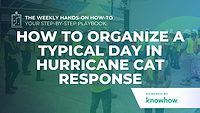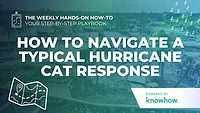Weekly Hands-on How-To powered by KnowHow
How To Plan Mobilization Efforts for Hurricane CAT Responses
A Comprehensive Guide to Hurricane CAT Response Mobilization from the KnowHow Team

All images courtesy of KnowHow
When a storm like Hurricane Milton barrels through a city, it leaves chaos in its wake, and upends lives in an instant. For restoration companies, this isn’t just a disaster, it’s a call to action. Hurricane CAT responses provide an opportunity to make a tangible difference, helping devastated communities recover and rebuild. But it’s not just about supporting those in need, it’s also the lifeblood of many of the companies prepared to respond at a moment’s notice.
Those who are properly prepared to act fast will reap the rewards—but getting there is no easy task. Mobilizing a team requires more than just boots on the ground—it demands precise coordination across logistics, finances, supplies, labor, and legal compliance. Without a solid plan, operations can stall, leaving both communities and clients without the urgent help they need. But with the right preparation and strategy, your team can jump into action, restore order, and make a lasting impact where it’s needed most.
In this how-to guide, powered by KnowHow, we’ll walk you through every step of hurricane mobilization—from securing lodging and supplies to managing insurance and knowing when to de-mobilize. Let’s “mobilize” and get your team ready to weather the storm.
Note: This Weekly Hands-On How-To was based on this template in KnowHow’s template library.
Step 1: Organize Logistics for Hurricane Mobilization
Setting up logistics is the backbone of an efficient CAT response. Start by deciding on a central location where the team can mobilize. This location will serve as your central hub for operations, containing your team’s lodging and command center (where you'll coordinate efforts, track progress, and manage communications) within close proximity.
Ensure that your command center is equipped with essential tools like maps, real-time tracking software, and communication devices to conduct your operations.
- Lodging and Meals: Secure lodging for your team, and confirm whether nearby restaurants and stores are open. If not, stock up on non-perishable food and water supplies.
- Establish Command Structure: Designate key personnel to oversee logistics, creating a clear chain of command for fast decision-making and effective communication.
- Briefing the Team: Provide team members with detailed instructions on their roles and responsibilities, ensuring smooth coordination throughout the mobilization effort.

Step 2: Plan and Secure Financing
Mobilizing for a hurricane response isn’t just about manpower—it’s about having the financial resources to make things happen fast. CAT response mobilization efforts will quickly become costly, so it’s essential to establish a budget and secure funding from the outset.
Start by outlining how much funding is required for supplies, labor, equipment, and administrative costs, and then develop a funding plan. Funding sources commonly include emergency reserves or lines of credit that ensure you have access to capital. Throughout your mobilization, always maintain transparency in financial transactions to stay organized and meet reimbursement or reporting requirements.
Step 3: Gather and Inspect Equipment
Effective disaster response hinges on reliable equipment, so everything from trucks tires to generators and safety gear must be in good condition, and ready for use.
- Pre-Deployment Check: Inspect everything from truck tires, to generators and safety equipment to avoid malfunctions on-site.
- Inventory Backup: Equipment and tools will inevitably break or malfunction, so bring spare parts and replacement tools to address any breakdowns on the go.
- Accessibility: Organize equipment for quick access, ensuring nothing delays operations when every second counts.

Step 4: Assemble Critical Supplies
Running out of essentials mid-operation isn’t an option. In the chaos of a hurricane response, your supplies need to support both your team and the affected community. Bringing the right supplies is key to sustaining your efforts.
Supplies should include:
- Basic Needs: Water, non-perishable food, blankets, hygiene products, and medical kits.
- Operational Tools: Flashlights, batteries, communication devices, and tents.
- Distribution Protocols: Establish a system to efficiently store, distribute, and replenish supplies throughout the operation.
- Vendor Coordination: Strong vendor partnerships can ensure that your crew can secure additional resources if supplies run low.
Step 5: Coordinate and Manage Labor
Building a strong, skilled labor force ensures your hurricane response runs efficiently. But it’s not just about recruiting able bodies—it’s about clear communication, proper preparation, and strategic deployment. With the right team and training, you’ll be able to respond faster, smarter, and safer.
- Assess Labor Needs: Determine the number of workers required and their skill sets.
- Clear Instructions: Provide workers with consistent updates and directions throughout the mobilization process.
- Training Sessions: Conduct brief training sessions frequently, even for experienced staff, to refresh disaster protocols and safety measures.

Step 6: Handle Administrative Tasks
Behind every successful field operation is a team working tirelessly behind the scenes. Administration may not always be glamorous, but without it, the entire mobilization can quickly fall apart. Proper organization ensures smooth communication, resource tracking, and compliance with all protocols.
Assign team members to manage tasks like filing paperwork, tracking resource allocation, and documenting communication channels.
- Documentation: Maintain records of emergency plans and all financial transactions to track progress and expenses.
- Communication Systems: Set up communication tools, ensuring that every team member and external partner has the information they need to stay aligned.
- Regular Updates: Schedule administrative reviews to stay responsive and adapt quickly to changing circumstances during the mobilization process.
Step 7: Understand Local Laws and Regulations
Operating in disaster zones means understanding and complying with local laws and regulations. The last thing you want is for red tape to slow down your response. By knowing which permits are required and what regulations apply, you’ll ensure that your team can act swiftly and avoid unnecessary legal complications
- Consult Legal Experts: Speak with legal advisors to understand safety regulations, liability issues, and environmental considerations.
- Permits and Regulations: Determine if special permits are required for debris removal or entry into restricted areas.
- Public Safety: Ensure your response plan aligns with local emergency declarations and public safety protocols.
Step 8: Review and Update Insurance Policies
Hurricane CAT responses come with serious risks—damaged equipment, injuries, and unforeseen losses. Having comprehensive insurance coverage ensures that your team is protected, no matter what happens. Conducting a detailed review of existing policies before deployment helps identify coverage gaps, saving you from surprises down the road.
- Policy Review: Assess your current policies to ensure sufficient coverage for equipment, personnel, and operations.
- Fill Coverage Gaps: Identify any missing coverage areas (e.g., Workers' Compensation) and seek endorsements if necessary.
- Claims Process: Document insurance provider contacts and claim procedures to streamline the claims process.
Step 9: Billing and Financial Tracking
With so many moving parts, from labor costs to supply purchases, it’s crucial to track expenses meticulously. Track expenses throughout the mobilization process to prepare for invoicing and financial reporting.
- Invoice Promptly: Create detailed invoices for equipment, labor, and supplies used during the response.
- Track Payments: Collect payments at the start and end of each job. Many companies choose to follow a “50% upfront, 50% upon completion” model.
- Reconcile Expenses: Work closely with your finance team to verify billing accuracy and address any discrepancies quickly.

Step 10: Know When to De-Mobilize
Knowing when to wind down operations is just as important as knowing how to start them. De-mobilizing too early risks leaving communities underserved, while delaying the process can waste valuable resources. A strategic de-mobilization plan ensures a smooth transition from emergency response to recovery.
- Final Assessment: Monitor progress toward key objectives to determine when it’s appropriate to scale down operations.
- Communication: Inform local authorities, stakeholders, and team members of the de-mobilization plan to ensure a smooth handoff.
- Prepare for Post-Response: Prepare your team to wrap up operations and prepare for any post-response responsibilities.
How To Stay Prepared for Every Scenario
Hurricane response is a demanding operation that requires detailed planning, seamless communication, and quick problem-solving. Even with the best-laid plans, every response will present unexpected challenges—but with the right systems in place, your team will be ready to meet them head-on.
This is where KnowHow comes in. KnowHow provides your team with instant access to SOPs, how-to’s, checklists, and training resources to ensure you can confidently manage every phase of the mobilization process—from logistics to insurance protocols. With KnowHow at your fingertips, your team stays organized, prepared, and ready for anything.
Visit tryknowhow.com today to learn more about how we help empower restorers to respond faster, smarter, and more confidently in any situation.
Looking for a reprint of this article?
From high-res PDFs to custom plaques, order your copy today!






